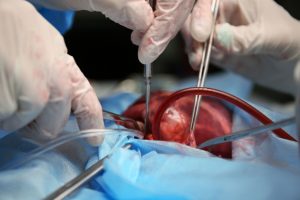Background: Performing a full-thickness intestinal wall resection of a sessile polyp located on the mesenteric side with a compression clip may lead to compression of mesenteric vessels. The application of such a clip may therefore cause a compromised blood supply in the particular bowel segment, leading to perforation.
Background: Performing a full-thickness intestinal wall resection of a sessile polyp located on the mesenteric
side with a compression clip may lead to compression of mesenteric vessels. The application of such a clip may
therefore cause a compromised blood supply in the particular bowel segment, leading to perforation.
Objective: To evaluate the performance of a newly developed, nitinol compression clip, called the NiTi clamp,
for full-thickness resection of the bowel wall, while the clip is deliberately deployed endoluminally on the
mesenteric side.
Design: Prospective animal study. Multinational, multidisciplinary; gastroenterology and general surgery,
research cooperation.
Setting: Animal research laboratory.
Intervention: Six pigs were operated upon and endoscopically evaluated and then killed after 3 weeks. Linear
compression closure clips based on nitinol springs were used. Three longitudinal enterotomies were performed:
in the cecum, spiral colon, and proximal rectum. Four clips were deployed in each animal.
Main Outcome Measurements: A total of 23 clips were deployed. The average expulsion day was 9 days.
Results: All but 3 clips were normally expelled. One pig developed bowel ischemia due to intussusception. In endoscopic procedures, no signs of significant segmental mucosal ischemia were found. The macroscopic appearance of the compression closure lines was thin and delicate, but epithelialization was significantly delayed at 5 sites.
Limitation: Differences between porcine and human colorectal anatomy.
Conclusion: Full-thickness clamping of the bowel with the NiTi clamp, including the local mesenteric vasculature, does not significantly impair local healing of the clamp site and gives hope to further development of novel
full-thickness endoscopic resection technologies. (Gastrointest Endosc 2009;70:1146-57.)






